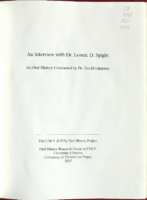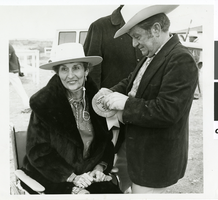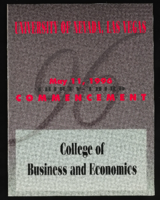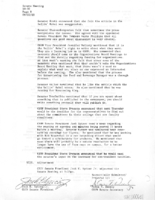Search the Special Collections and Archives Portal
Search Results
Ernest Clary Papers on Basic Magnesium, Inc. Engineering Plans
Identifier
Abstract
The Ernest Clary Papers on Basic Magnesium, Inc. Engineering Plans (1941-1944) contain an essay written by Clary formalizing the engineering process in building Basic Magnesium, Inc. (BMI). Also included are maps of the area around the plant and site maps of the main BMI structures.
Archival Collection

Transcript of interview with Dr. Lonnie D. Spight by Dr. David Emerson, May 8, 2007
Date
Archival Collection
Description
Text

Photograph of Judy Bayley and Senator Howard Cannon at one of the trailrides, Las Vegas, Nevada, circa 1968-1971.
Date
Archival Collection
Description
Image

University of Nevada, Las Vegas (UNLV) College of Business and Economics 33rd commencement program
Date
Archival Collection
Description
Commencement program from University of Nevada, Las Vegas Commencement Programs and Graduation Lists (UA-00115).
Text

Meeting minutes for Consolidated Student Senate University of Nevada, Las Vegas, September 22, 1988
Date
Archival Collection
Description
Text

Meeting minutes for Consolidated Student Senate, University of Nevada, Las Vegas, March 10, 2000
Date
Archival Collection
Description
Text

Transcript of an interview with Kenneth Fong by Lois Goodall on February 22, 2014
Date
Archival Collection
Description
Text
Donald Welch Photograph Collection
Identifier
Abstract
The Donald Welch Photograph Collection (approximately 1961-1981) is comprised of photographs of various golf tournaments hosted at the Desert Inn Country Club in Las Vegas, Nevada collected by Welch throughout his career as the Desert Inn's head golf professional. In particular, the collection includes two photograph albums depicting the Ladies Professional Golf Association (LPGA) Sealy golf tournament in the early 1970s and a 25th anniversary Desert Inn Country Club commemorative photograph book from 1981.
Archival Collection
UNLV Libraries Collection of Barbary Coast Hotel and Casino Promotional Materials
Identifier
Abstract
UNLV Libraries Collection of Barbary Coast Hotel and Casino Promotional Materials includes clippings, press releases, press kits, and promotional materials for the Barbary Coast Hotel and Casino in Las Vegas, Nevada, dating from 1989 to 1997.
Archival Collection
Mike Miller Papers
Identifier
Abstract
The Mike Miller Papers (1971-2014) include advertisements, books, and paintings by Las Vegas, Nevada-based artist and graphic designer Mike Miller. Materials include photographs, art prints, advertisements, newspaper clippings featuring Miller's advertisements, casino advertisements, and books designed, written, or illustrated by Miller.
Archival Collection
